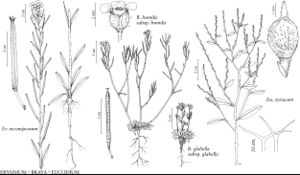Braya
Denkschr. Königl.-Baier. Bot. Ges. Regensburg 1(1): 65. 1815.
Perennials; (sometimes pulvinate, caudex simple or many-branched); scapose or not; usually pubescent or pilose, sometimes glabrous, trichomes short-stalked, forked, subdendritic, or submalpighiaceous, mixed with simple ones (rarely exclusively). Stems erect to decumbent or ascending, unbranched or branched. Leaves basal and, sometimes, cauline; petiolate or sessile; basal rosulate, petiolate, blade margins entire, sinuate, dentate, or, rarely, pinnately lobed; cauline usually absent, rarely few present, (sub) sessile, blade margins usually entire, rarely dentate or pinnately lobed. Racemes (corymbose, sometimes bracteate basally or throughout), elongated or not in fruit. Fruiting pedicels erect, divaricate, or ascending, slender (much narrower than fruit). Flowers: sepals [sometimes persistent], oblong [ovate], lateral pair not saccate basally (sometimes slightly so in B. humilis and B. linearis); petals white, pink, or purple [rarely pale-yellow], obovate, oblanceolate, or spatulate, (slightly to much longer than sepals), claw distinct or not, (shorter than sepal, apex obtuse or rounded); stamens tetradynamous; filaments dilated or not basally; anthers ovate or oblong, (apex usually obtuse, sometimes apiculate); nectar glands (4), lateral, 1 on each side of lateral stamen. Fruits siliques or silicles, sessile, linear, oblong, cylindrical, oval-elliptic, ovoid, lanceoloid, lanceoloid-subulate, or globose, smooth or torulose, terete or slightly latiseptate; valves each often with prominent midvein, glabrous or pubescent; replum rounded; septum complete, (membranous, translucent); ovules (5–) 14–44 per ovary; stigma capitate, entire or slightly 2-lobed. Seeds plump, not winged, oblong or ovoid; seed-coat (minutely reticulate), not mucilaginous when wetted; cotyledons incumbent. x = 7.
Distribution
North America, n Europe, Asia
Discussion
Species 17 (7 in the flora).
Selected References
Lower Taxa
Key
| 1 | Plants not scapose; cauline leaves (1 or) 2-4; fruits linear; seeds usually uniseriate, rarely weakly biseriate | > 2 |
| 1 | Plants scapose; cauline leaves 0 or 1 (or with leaflike bract subtending proximalmost pedicel); fruits ovoid, globose, oval-elliptic, oblong, oblong-elliptic, oblong-lanceoloid, or lanceoloid-subulate, not linear; seeds usually biseriate (uniseriate in B. fernaldii and, sometimes, B. longii) | > 3 |
| 2 | Cauline leaves 3 or more; basal leaves (0.3-)0.5-2(-3.5) cm × 1-8(-10) mm; racemes elongated in fruit; fruits (0.9-)1.2-2.5(-3.2) cm | Braya humilis |
| 2 | Cauline leaves 1-4; basal leaves 0.5-3 cm × 0.5-2(-3) mm; racemes not elongated in fruit; fruits (0.5-)0.9-1.2(-1.4) cm. | Braya linearis |
| 3 | Fruits ovoid or globose | > 4 |
| 3 | Fruits oval-elliptic, oblong, oblong-elliptic, oblong-lanceoloid, or lanceoloid-subulate | > 5 |
| 4 | Petals 4.7-6.6 × 3-5.1 mm; styles 1.2-2(-2.5) mm; stems erect to ascending. | Braya pilosa |
| 4 | Petals 2-3.7 × 1-1.5 mm; styles obsolete to 0.7(-1) mm; stems usually decumbent to prostrate, sometimes ascending. | Braya thorild-wulffii |
| 5 | Fruits oval-elliptic, oblong-cylindrical, or lanceoloid; septum margins not expanded basally (not forming sacklike pouch around proximalmost seeds); seeds biseriate. | Braya glabella |
| 5 | Fruits lanceoloid-subulate; septum margins broadly expanded basally (forming sacklike pouch around proximalmost seeds); seeds somewhat to nearly uniseriate | > 6 |
| 6 | Fruit valves pubescent; petals 2.4-3.8(-4) × (0.8-)1-1.3(-2) mm, (claws often not well- differentiated from blades). | Braya fernaldii |
| 6 | Fruit valves glabrous or sparsely pubescent; petals (3-)3.3-4.8(-5) × (1.2-)1.4-2.5(-3) mm, (claws usually well-differentiated from blades). | Braya longii |
"not" is not a number. "elongated" is not a number."thick" is not a number.
